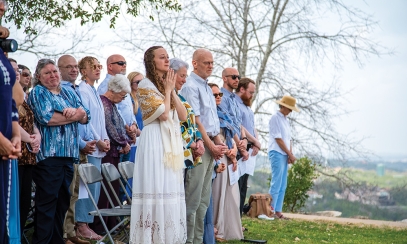
Popular Christmas traditions founded by saints
The world marks Dec. 25 as the commemoration of the birth of Jesus in the festival of Christmas. It is the oldest specifically Christian feast. In the second and third centuries, Dec. 25 was the Roman day of the winter solstice, a pagan festival. In 354 Pope Liberius chose the date of Dec. 25 as the solemnity of the birth of Jesus.
The world marks Dec. 25 as the commemoration of the birth of Jesus in the festival of Christmas. It is the oldest specifically Christian feast. In the second and third centuries, Dec. 25 was the Roman day of the winter solstice, a pagan festival. In 354 Pope Liberius chose the date of Dec. 25 as the solemnity of the birth of Jesus.
Some of the most popular Christmas traditions were begun by saints from centuries past doing very ordinary things.
One of the earliest saints in church history was St. Ephraem of Syria (306-73). He is the author of the Hymns on the Nativity of Christ in the Flesh, some of the earliest poetry on the Nativity.
The giving of gifts is probably the most obvious tradition that has come down through the centuries. That custom seems to have begun with the fourth century bishop of Myra, St. Nicholas. Paul Burns writes in Butler’s Lives of the Saints that Nicholas heard of a man in his hometown of Patara who had lost all his money, leaving his three daughters without dowries and the possibility of marriage.
The legend describes how Nicholas threw a bag of gold into the man’s house, and the oldest daughter was able to be married. Later, he threw another bag for the second daughter and then again, a third bag for the youngest daughter.
Nicholas later became identified with Father Christmas and Santa Claus. Bernard Bangley writing in Butler’s Lives of the Saints credits the German-born American artist Thomas Nast with popularizing the present-day icon of Santa Claus with his drawings.
In Sweden there is a charming Christmas custom centering around St. Lucia, an early fourth century maiden. Tasha Tudor writes in “Take Joy!” that the custom now known as the Lucia Queen takes place on Dec. 13. The youngest daughter in Swedish homes is usually chosen to be the Lucia Queen. She brings breakfast and a Christmas song to all in the family.
And it is because of St. Francis of Assisi’s devotion to the Christ Child that the crèche has a prominent place today in Christmas decorations. Francis was born in 1181, the son of a wealthy merchant. As a young man, he spent large sums on easy living, song, drink and extravagance. He made a complete change in his life after a vision at Spoleto.
Francis gave away all his possessions, angering his father, who disinherited him. He then devoted himself to a life of poverty and the care of the sick and poor. He attracted followers and began the order of Friars Minor, now known as the Franciscans. Gerry Fowler writes in The World Encyclopedia of Christmas that Francis staged the first live re-enactment of the Nativity outside a church in Greccio, Italy, in 1223 as a memorial of Jesus’ humble birth. Since then the practice has spread around the world.
The legend of the Three Kings from the East has its source in part from the visions of Veronica of Binasco, an Augustinian lay sister who collected alms for the poor in Milan, Italy, in the late 15th century. She had many visions, and some of them influenced how the Renaissance artists portrayed the Three Kings. Veronica described one of her visions thusly: “As the kings approached the Christ Child, they began to argue about who would adore him first. The youngest, and most impetuous one, approached first and kissed the Infant’s feet. He then aged before the eyes of the other two kings until he was as old as them.”
The testaments of saints like Veronica are considered private revelations and not church dogma. However, they have had a great influence on how we picture the Nativity scene today.
Mary Lou Gibson is a freelance writer who loves to explore the lives of saints. She is a member of St. Austin Parish in Austin.



